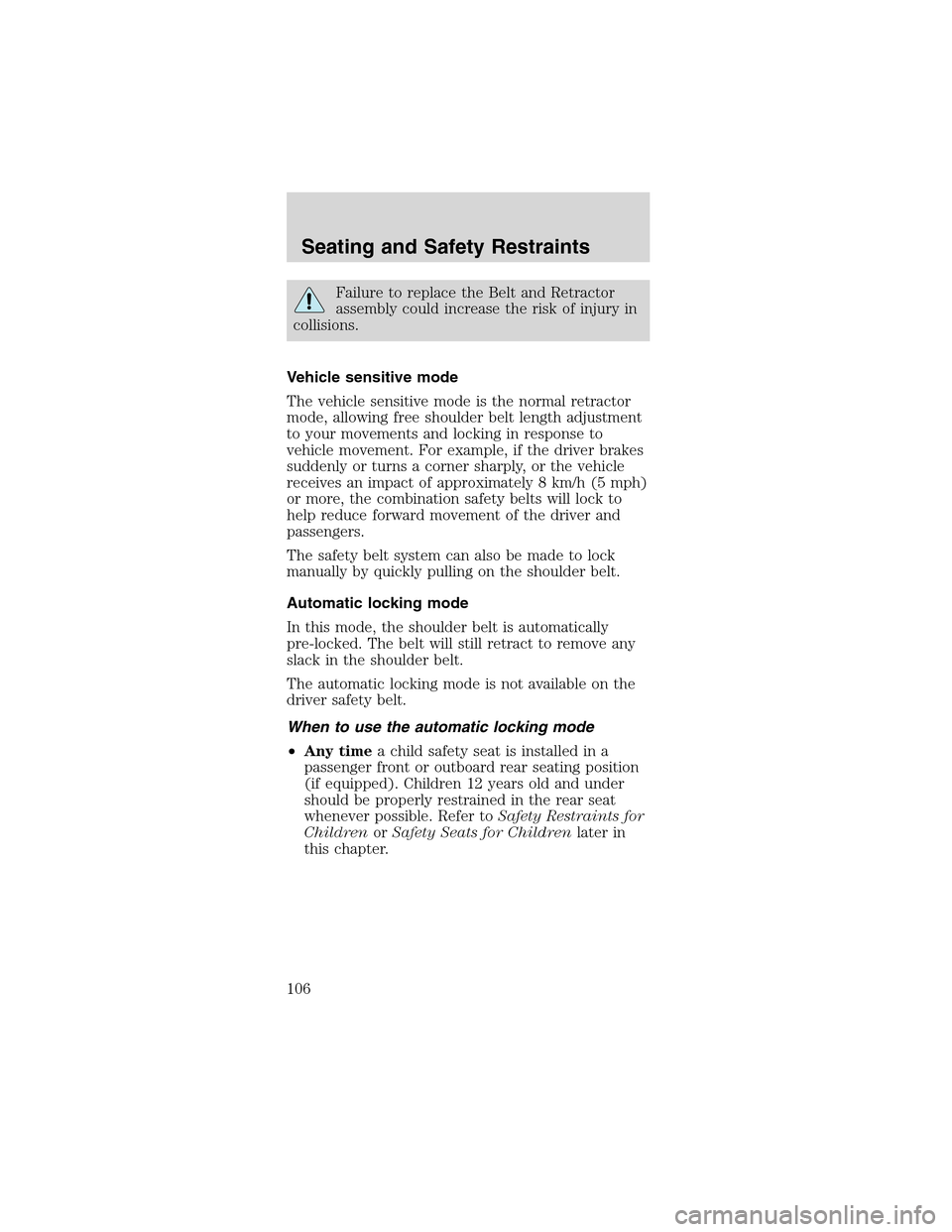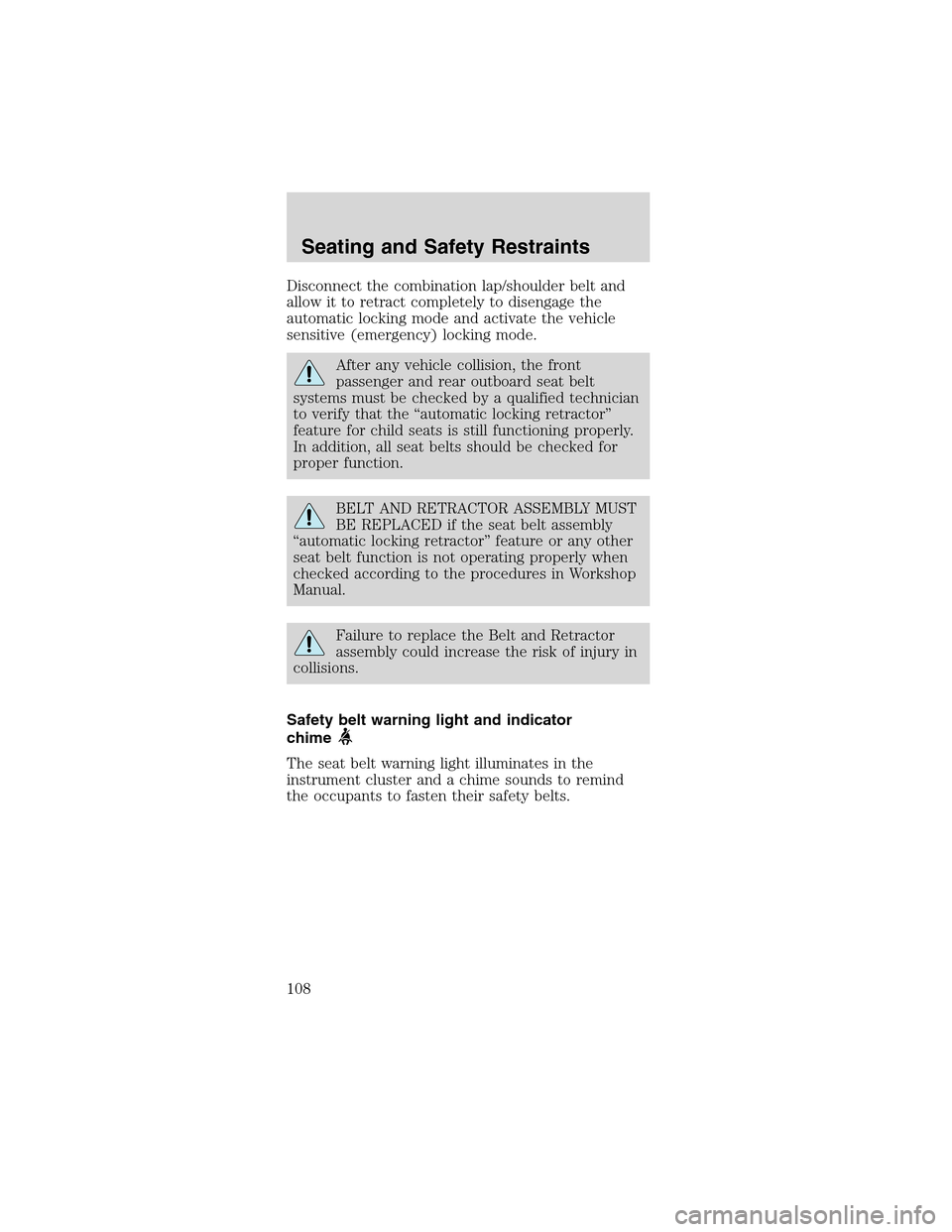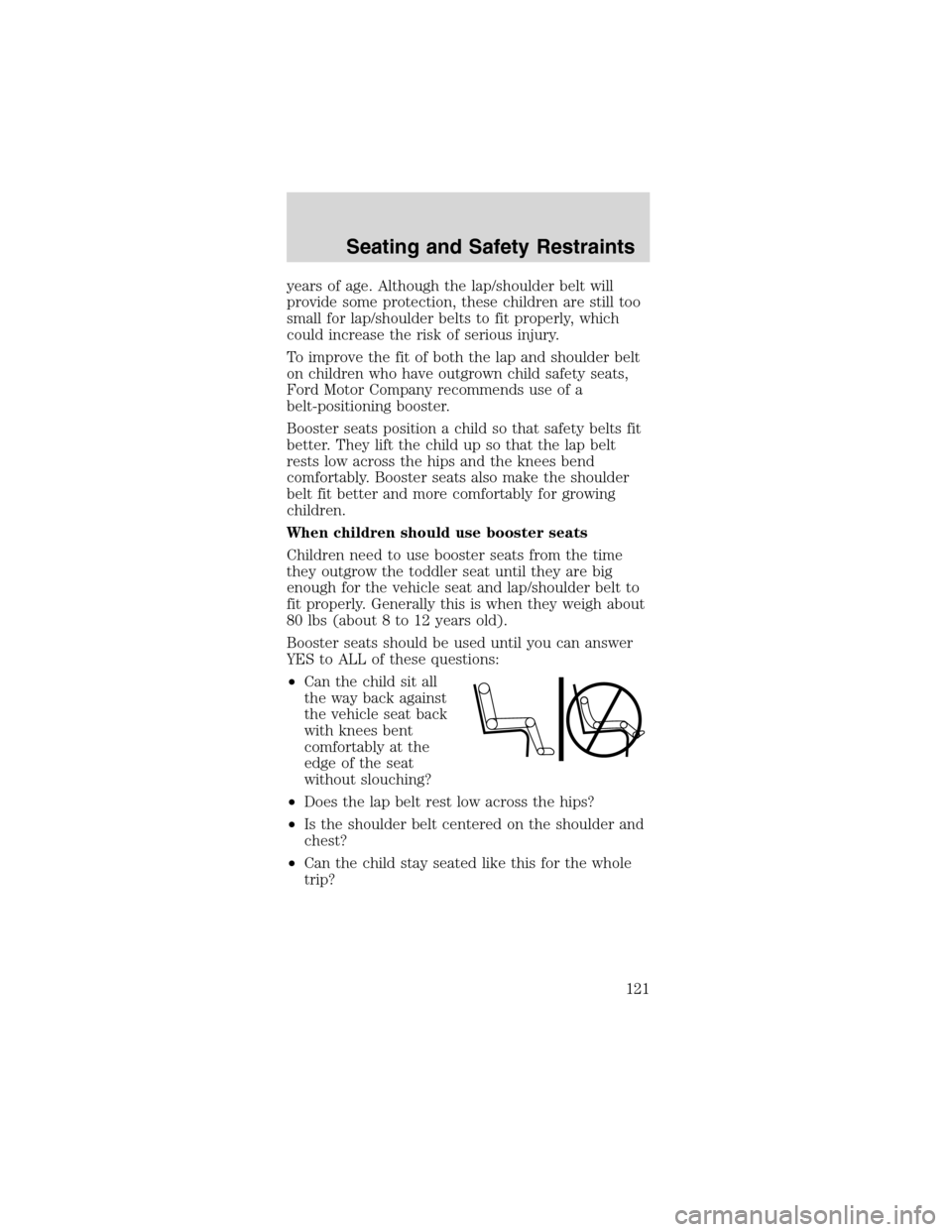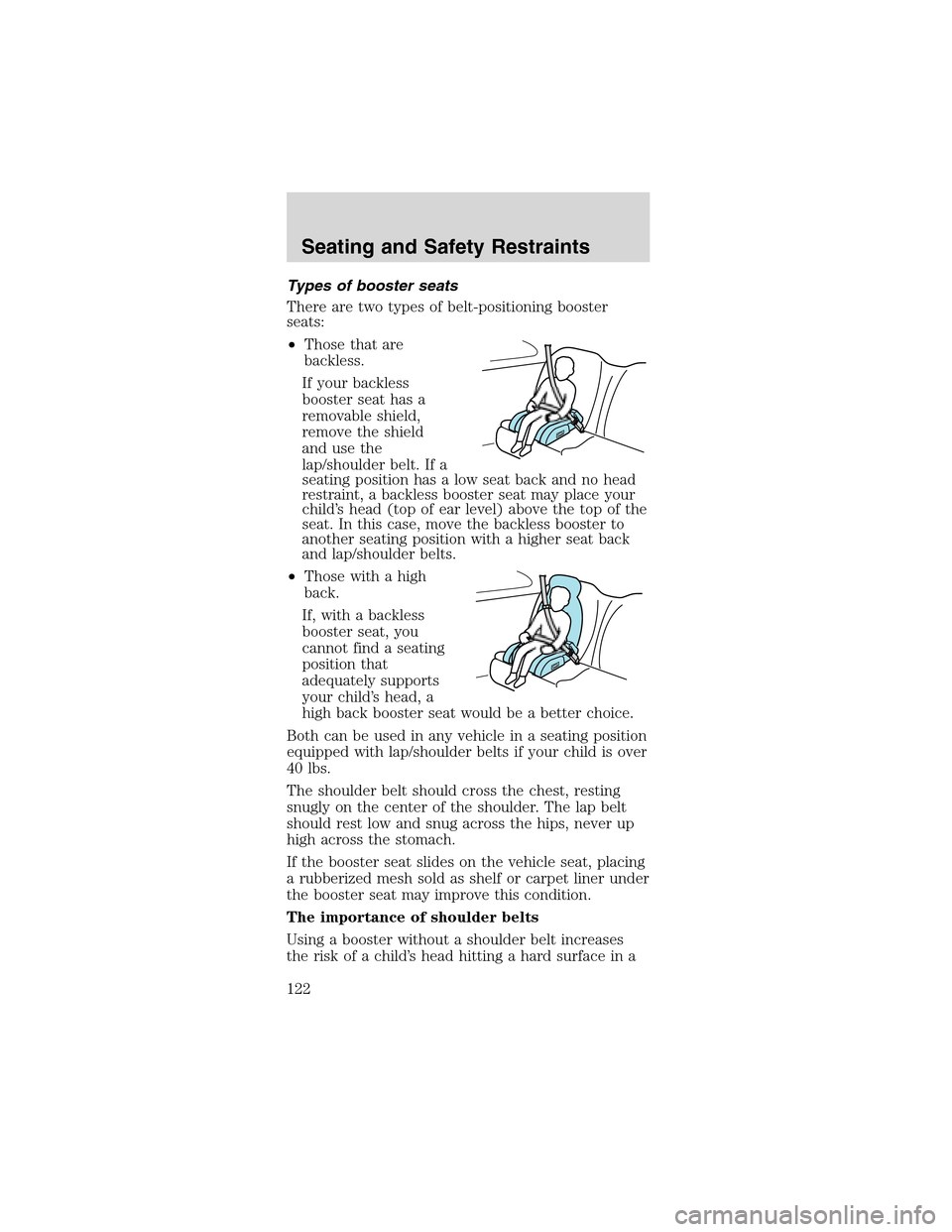Page 106 of 256

Failure to replace the Belt and Retractor
assembly could increase the risk of injury in
collisions.
Vehicle sensitive mode
The vehicle sensitive mode is the normal retractor
mode, allowing free shoulder belt length adjustment
to your movements and locking in response to
vehicle movement. For example, if the driver brakes
suddenly or turns a corner sharply, or the vehicle
receives an impact of approximately 8 km/h (5 mph)
or more, the combination safety belts will lock to
help reduce forward movement of the driver and
passengers.
The safety belt system can also be made to lock
manually by quickly pulling on the shoulder belt.
Automatic locking mode
In this mode, the shoulder belt is automatically
pre-locked. The belt will still retract to remove any
slack in the shoulder belt.
The automatic locking mode is not available on the
driver safety belt.
When to use the automatic locking mode
•Any timea child safety seat is installed in a
passenger front or outboard rear seating position
(if equipped). Children 12 years old and under
should be properly restrained in the rear seat
whenever possible. Refer toSafety Restraints for
ChildrenorSafety Seats for Childrenlater in
this chapter.
Seating and Safety Restraints
106
Page 108 of 256

Disconnect the combination lap/shoulder belt and
allow it to retract completely to disengage the
automatic locking mode and activate the vehicle
sensitive (emergency) locking mode.
After any vehicle collision, the front
passenger and rear outboard seat belt
systems must be checked by a qualified technician
to verify that the“automatic locking retractor”
feature for child seats is still functioning properly.
In addition, all seat belts should be checked for
proper function.
BELT AND RETRACTOR ASSEMBLY MUST
BE REPLACED if the seat belt assembly
“automatic locking retractor”feature or any other
seat belt function is not operating properly when
checked according to the procedures in Workshop
Manual.
Failure to replace the Belt and Retractor
assembly could increase the risk of injury in
collisions.
Safety belt warning light and indicator
chime
The seat belt warning light illuminates in the
instrument cluster and a chime sounds to remind
the occupants to fasten their safety belts.
Seating and Safety Restraints
108
Page 120 of 256
![FORD MUSTANG 2003 4.G Owners Manual years old or younger and who weigh 18 kg [40 lbs]
or less), you must put them in safety seats made
especially for children. Check your local and state or
provincial laws for specific requirements rega FORD MUSTANG 2003 4.G Owners Manual years old or younger and who weigh 18 kg [40 lbs]
or less), you must put them in safety seats made
especially for children. Check your local and state or
provincial laws for specific requirements rega](/manual-img/11/5211/w960_5211-119.png)
years old or younger and who weigh 18 kg [40 lbs]
or less), you must put them in safety seats made
especially for children. Check your local and state or
provincial laws for specific requirements regarding
the safety of children in your vehicle.
Never let a passenger hold a child on his or
her lap while the vehicle is moving. The
passenger cannot protect the child from injury in a
collision.
Always follow the instructions and warnings that
come with any infant or child restraint you might
use.
When possible, always place children under age
12 in the rear seat of your vehicle.Accident
statistics suggest that children are safer when
properly restrained in the rear seating positions than
in the front seating positions.
Children and safety belts
If the child is the proper size, restrain the child in a
safety seat. Children who are too large for child
safety seats (as specified by your child safety seat
manufacturer) should always wear safety belts.
Follow all the important safety restraint and air bag
precautions that apply to adult passengers in your
vehicle.
If the shoulder belt portion of a combination lap and
shoulder belt can be positioned so it does not cross
or rest in front of the child’s face or neck, the child
should wear the lap and shoulder belt. Moving the
child closer to the center of the vehicle may help
provide a good shoulder belt fit.
Do not leave children, unreliable adults, or
pets unattended in your vehicle.
Child booster seats
Children outgrow a typical convertible or toddler
seat when they weigh 40 pounds and are around 4
Seating and Safety Restraints
120
Page 121 of 256

years of age. Although the lap/shoulder belt will
provide some protection, these children are still too
small for lap/shoulder belts to fit properly, which
could increase the risk of serious injury.
To improve the fit of both the lap and shoulder belt
on children who have outgrown child safety seats,
Ford Motor Company recommends use of a
belt-positioning booster.
Booster seats position a child so that safety belts fit
better. They lift the child up so that the lap belt
rests low across the hips and the knees bend
comfortably. Booster seats also make the shoulder
belt fit better and more comfortably for growing
children.
When children should use booster seats
Children need to use booster seats from the time
they outgrow the toddler seat until they are big
enough for the vehicle seat and lap/shoulder belt to
fit properly. Generally this is when they weigh about
80 lbs (about 8 to 12 years old).
Booster seats should be used until you can answer
YES to ALL of these questions:
•Can the child sit all
the way back against
the vehicle seat back
with knees bent
comfortably at the
edge of the seat
without slouching?
•Does the lap belt rest low across the hips?
•Is the shoulder belt centered on the shoulder and
chest?
•Can the child stay seated like this for the whole
trip?
Seating and Safety Restraints
121
Page 122 of 256

Types of booster seats
There are two types of belt-positioning booster
seats:
•Those that are
backless.
If your backless
booster seat has a
removable shield,
remove the shield
and use the
lap/shoulder belt. If a
seating position has a low seat back and no head
restraint, a backless booster seat may place your
child’s head (top of ear level) above the top of the
seat. In this case, move the backless booster to
another seating position with a higher seat back
and lap/shoulder belts.
•Those with a high
back.
If, with a backless
booster seat, you
cannot find a seating
position that
adequately supports
your child’s head, a
high back booster seat would be a better choice.
Both can be used in any vehicle in a seating position
equipped with lap/shoulder belts if your child is over
40 lbs.
The shoulder belt should cross the chest, resting
snugly on the center of the shoulder. The lap belt
should rest low and snug across the hips, never up
high across the stomach.
If the booster seat slides on the vehicle seat, placing
a rubberized mesh sold as shelf or carpet liner under
the booster seat may improve this condition.
The importance of shoulder belts
Using a booster without a shoulder belt increases
the risk of a child’s head hitting a hard surface in a
Seating and Safety Restraints
122
Page 123 of 256
collision. For this reason, you should never use a
booster seat with a lap belt only. It is best to use a
booster seat with lap/shoulder belts in the back seat-
the safest place for children to ride.
Follow all instructions provided by the
manufacturer of the booster seat.
Never put the shoulder belt under a child’s
arm or behind the back because it
eliminates the protection for the upper part of the
body and may increase the risk of injury or death
in a collision.
Never use pillows, books, or towels to boost
a child. They can slide around and increase
the likelihood of injury or death in a collision.
SAFETY SEATS FOR CHILDREN
Child and infant or child safety seats
Use a safety seat that is recommended for the size
and weight of the child. Carefully follow all of the
manufacturer’s instructions with the safety seat you
Seating and Safety Restraints
123
Page 124 of 256

put in your vehicle. If you do not install and use the
safety seat properly, the child may be injured in a
sudden stop or collision.
When installing a child safety seat:
•Review and follow
the information
presented in theAir
bag supplemental
restraint system
(SRS) section in this
chapter.
•Use the correct
safety belt buckle for that seating position (the
buckle closest to the direction the tongue is
coming from).
•Insert the belt tongue into the proper buckle until
you hear a snap and feel it latch. Make sure the
tongue is securely fastened in the buckle.
•Keep the buckle release button pointing up and
away from the safety seat, with the tongue
between the child seat and the release button, to
prevent accidental unbuckling.
•Place seat back in upright position.
•Put the safety belt in the automatic locking mode.
Refer toAutomatic locking mode(passenger
side front and outboard rear seating positions) (if
equipped) section in this chapter.
Ford recommends the use of a child safety seat
having a top tether strap. Install the child safety seat
in a seating position which is capable of providing a
tether anchorage. For more information on top
tether straps, refer toAttaching child safety seats
with tether straps.in this chapter.
Carefully follow all of the manufacturer’s
instructions included with the safety seat
you put in your vehicle. If you do not install and
use the safety seat properly, the child may be
injured in a sudden stop or collision.
Seating and Safety Restraints
124
Page 125 of 256
Installing child safety seats in combination lap
and shoulder belt seating positions
If you must use a
forward facing child
seat in the front seat
(reminder - children 12
years old and under
should always be
properly restrained in
the rear seat)the
shoulder belt must
be routed through
the belt guide at the
top of the seatback,
refer toSafety
Restraintsearlier in
this chapter for routing
through the belt holder.
Air bags can kill or injure a child in a child
seat.NEVERplace a rear-facing child seat
in front of an active air bag. If you must use a
forward-facing child seat in the front seat, move
the seat all the way back.
1. Position the child
safety seat in a seat
with a combination lap
and shoulder belt.
Children 12 and under should be properly
restrained in the rear seat whenever
possible.
Seating and Safety Restraints
125